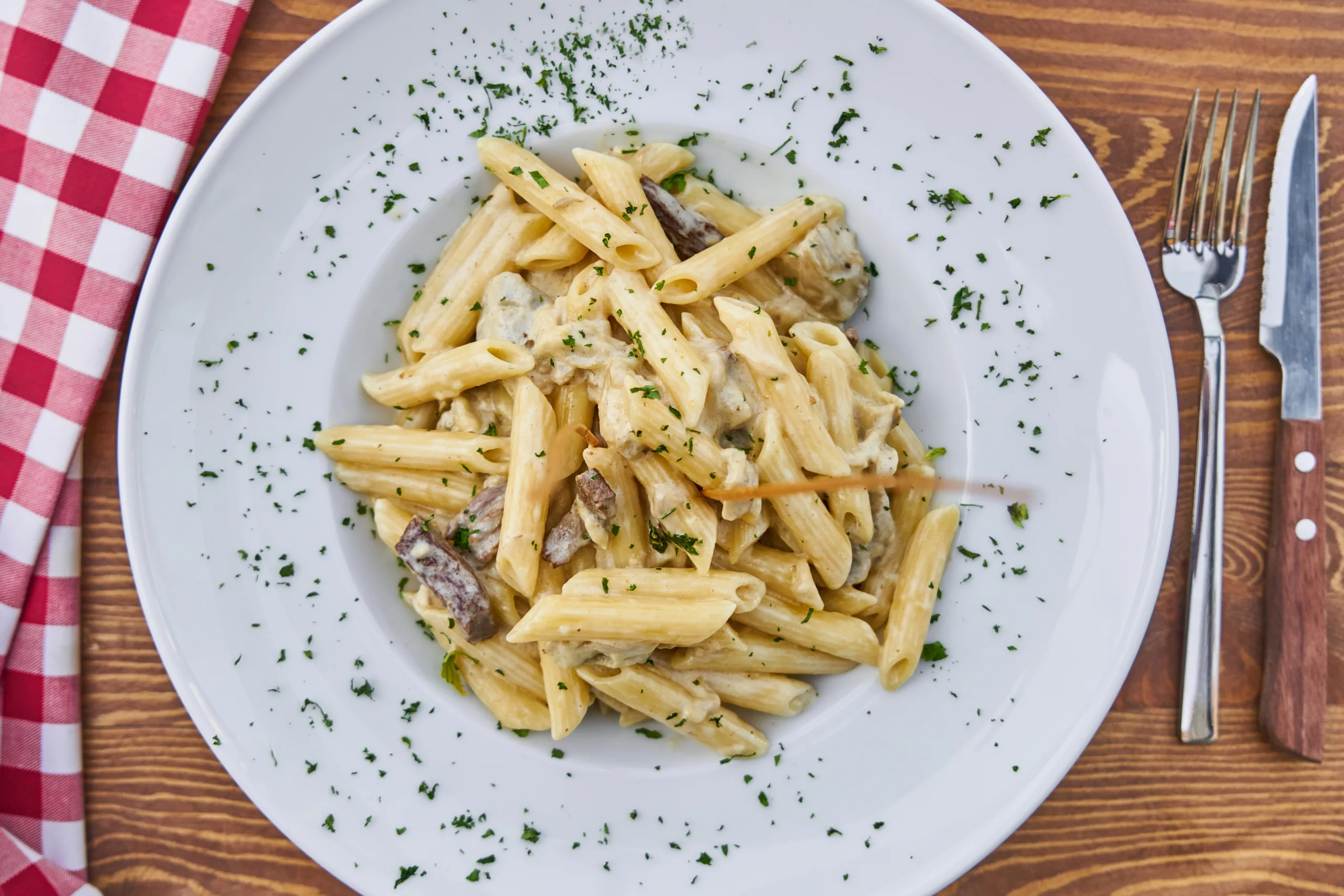Eating out can be a daunting task if you’re following a low FODMAP diet. It can be hard to know what foods are safe to eat and which ones contain ingredients that could cause an uncomfortable reaction.
If you’re looking for information on how to eat low FODMAP at restaurants, you’ve come to the right place! In this article, we’ll provide tips on how to navigate menus, what to ask when ordering, and which dishes are typically low FODMAP friendly. With these tools in hand, you can enjoy eating out with confidence and without fear of triggering uncomfortable digestive symptoms.
So let’s get started and learn how to successfully navigate restaurants while following the low FODMAP diet!Eating Low FODMAP at restaurants can be a challenge, but there are some tips you can use to make it easier. Firstly, always research the restaurant and its menu prior to visiting, so you know what foods are available that fit within the Low FODMAP diet. Secondly, ask your server for advice on which dishes are suitable for your needs and try to avoid ordering anything with garlic or onion as both of these ingredients are high in FODMAPs. Finally, don’t be afraid to speak up and ask for special modifications if needed – many restaurants are happy to accommodate dietary restrictions.
Understanding Low FODMAP Diets
The low FODMAP diet is a specialized eating plan developed to help reduce the symptoms of IBS and other digestive disorders. It has become increasingly popular in recent years due to its effectiveness in managing symptoms of digestive issues. The diet involves limiting or avoiding certain foods that are high in fermentable carbohydrates, also known as FODMAPs. While it can be intimidating to try a new diet, understanding the basics of a low FODMAP diet can help make it easier to follow.
FODMAPs are short-chain carbohydrates found in many common foods that are not well absorbed in the gut. These carbohydrates are fermented by bacteria in the large intestine, which can lead to uncomfortable symptoms like bloating, gas, and abdominal pain. A low FODMAP diet eliminates foods high in these carbohydrates while still providing adequate nutrition.
When following a low FODMAP diet, it’s important to be aware of which foods contain FODMAPs and which do not. Foods that are high in FODMAPs include certain fruits and vegetables such as apples, pears, garlic, onions, legumes like beans and lentils, dairy products like milk and yogurt, wheat-based products like bread and pasta, as well as artificial sweeteners such as sorbitol and mannitol.
On the other hand, there are many foods that are considered safe on a low FODMAP diet such as bananas, oranges, spinach, tomatoes, oats, quinoa, potatoes and rice-based products like noodles or crackers. In addition to these foods being low in fermentable carbohydrates they also provide important nutrients for overall health.
When beginning a low FODMAP diet it’s important to take things slow. Start by eliminating only one food at a time for several days or weeks before adding something back into your diet. This allows you time to observe any changes in your symptoms before introducing something else into your meal plan. Additionally consulting with a registered dietitian can help you create an individualized meal plan that fits your needs.
Overall understanding the basics of a low FODMAP diet can help make it easier to follow while helping you manage your digestive issues more effectively. With proper guidance and patience this type of eating plan can be beneficial for those with IBS or other digestive disorders.
Identifying High FODMAP Foods
FODMAPs, or Fermentable Oligosaccharides, Disaccharides, Monosaccharides and Polyols, are a group of carbohydrates found in many foods. They can be difficult to digest and can cause uncomfortable digestive symptoms in some people. Identifying which foods contain high FODMAPs is the first step in avoiding them. High FODMAP foods include garlic, onions, apples, pears, wheat, legumes, dairy products and processed foods containing sweeteners such as sorbitol and mannitol.
Click here to preview your posts with PRO themes ››
Avoiding High FODMAP Foods
Once you have identified which foods contain high FODMAPs, it is important to avoid them to reduce digestive symptoms. This may mean avoiding certain food groups altogether or limiting your intake of certain high FODMAP foods. For example, if you are sensitive to onions or garlic you may want to avoid them altogether or limit your intake of them. You may also need to limit the amount of wheat-based products you eat or switch to gluten-free alternatives such as rice and quinoa. Dairy products should also be limited if they contain lactose or other high FODMAP ingredients.
Identifying Low FODMAP Foods
In addition to avoiding high FODMAP foods it is important to identify low FODMAP foods that can help reduce digestive symptoms. Low FODMAP foods include fruits such as bananas and oranges; vegetables such as carrots, potatoes and sweet potatoes; lean proteins such as chicken and fish; grains such as rice and quinoa; nuts and seeds; dairy-free milk alternatives; and gluten-free flours such as almond flour.
Following a Low FODMAP Diet
Following a low FODMAP diet can help reduce digestive symptoms by limiting the amount of high FODMAP foods consumed. It is important to consult with a registered dietitian first so they can help you identify which food groups you should limit or avoid completely. A dietitian can also provide guidance on how much of each food group should be consumed for optimal health benefits. Following a low FODMAP diet can help reduce digestive symptoms but it is important to remember that everyone’s body is different so what works for one person may not work for another.
Planning Ahead for Eating Out Low FODMAP
Eating out can be challenging when following a low FODMAP diet. However, with a bit of planning, it is possible to enjoy a restaurant meal without worrying about triggers. Start by researching restaurants that are familiar with the diet and offer low FODMAP menu items. Once you have chosen the restaurant, check out their menu online and make a plan about what you would like to order before you arrive. This will help reduce stress and make ordering easier when you get there.
It is also important to talk to your server about your dietary needs. If possible, give them as much information as you can so they can help you choose the best option from the menu. Don’t forget to ask what ingredients are in each item so that you can make an informed decision about what to order.
When eating out, it is also important to be mindful of portion sizes and avoid overeating. While it can be tempting to try all the delicious items on the menu, having too much of any one food may trigger uncomfortable symptoms. Try sticking with smaller portions or sharing dishes with friends or family members if possible.
Finally, keep in mind that eating out doesn’t mean giving up all your dietary restrictions completely; instead, focus on enjoying time spent with friends or family and savoring each bite of food without feeling guilty or overwhelmed.
Planning Ahead for Eating Out Low FODMAP
Being prepared ahead of time is key when eating out on a low FODMAP diet. Research restaurants that are familiar with the diet and offer low FODMAP menu items before making a reservation or deciding where to eat. Check out their menus online beforehand so that you know what options are available and plan which meals you would like to order before arriving at the restaurant. This will help reduce stress and make ordering easier when you get there.
When at the restaurant, it is important to talk to your server about your dietary needs so they can help guide you towards making the best choices from the menu. Make sure to ask them questions about ingredients in each dish so that you can make an informed decision about what foods are safe for your body.
Click here to preview your posts with PRO themes ››
Remember not to overindulge when eating out; stick with smaller portions or share dishes if possible since having too much of any one food may trigger uncomfortable symptoms for those following a low FODMAP diet . Enjoying time spent with friends or family should be the primary focus rather than worrying about every little thing on our plate!
Understanding Restaurant Menus
Dining out can be a challenging experience, especially if you are unfamiliar with the menu. Whether it’s your first time in a restaurant or if you’ve been there multiple times, it’s important to know how to read the menu and make an informed decision about what to order. It can help to understand the basics of restaurant terminology and how different dishes are prepared. Once you understand these concepts, you can make an educated decision about what to eat and enjoy a successful dining experience.
When looking at a restaurant menu, it is important to recognize the type of cuisine offered. Many restaurants specialize in certain types of food such as Italian, French, Chinese, Japanese, or Mediterranean. Knowing which type of cuisine is being offered will help you decide which dishes may be best suited for your preferences. Additionally, looking at any pictures on the menu can help with visualizing what the dish may look like before ordering.
Another key element of understanding a restaurant menu is recognizing common terms and descriptions that are used to describe dishes. For example, when reading a description such as “pan-seared salmon with vegetables” you should understand that this means the salmon was cooked in a pan on the stove top and served with vegetables. Understanding this language helps when deciding which dish to order as well as making sure any dietary restrictions are followed correctly.
Finally, it is important to recognize different preparation methods such as sautéed, grilled, fried, or baked. Knowing how each dish is cooked can help determine which dish will meet your preferences best. For example if you prefer food that has less fat content then ordering something that is sautéed or grilled would be better than something that has been fried.
By understanding basic terminology on restaurant menus and recognizing different preparation methods and cuisine types, diners are better equipped to make informed decisions when selecting their meal. With these tips in mind it can be easier for anyone to enjoy their dining experience without worrying about making the wrong choice!

Talking to Restaurant Staff about Low FODMAP Diet
When eating out, it is important to understand the low FODMAP diet and how to communicate it to restaurant staff. The low FODMAP diet is a restrictive diet designed to help those with irritable bowel syndrome manage their symptoms. It involves avoiding certain high-FODMAP foods that can cause digestive discomfort. When dining out, it is important to alert the restaurant staff of your dietary restrictions so that they can make suitable menu adjustments for you.
The best way to ensure your meal is low in FODMAPs is to ask questions about the ingredients used in each dish. This will help you identify what items on the menu are safe for you and which should be avoided. It is also important to ask if there are any dishes that can be made with alternative ingredients that are lower in FODMAPs. For example, if a dish contains garlic or onions, ask if they can be left out or substituted for other vegetables that are lower in FODMAPs such as carrots or bell peppers.
It is also helpful to inform the restaurant staff of any food allergies you may have so they can make sure they do not accidentally use ingredients you may be allergic too. This will help prevent any potential reactions and ensure your meal is safe and enjoyable.
Finally, it’s important to remember that following a low FODMAP diet does not mean sacrificing flavor or enjoyment when dining out. Many restaurants offer creative dishes that are both delicious and low in FODMAPs so don’t be afraid to ask questions and explore the menu!
Click here to preview your posts with PRO themes ››
Avoiding Cross-Contamination at Restaurants
Cross-contamination is a major concern when eating out at restaurants. It occurs when one type of food, such as raw meat, comes into contact with another type of food, such as cooked vegetables. This can cause bacteria and other contaminants to spread and lead to foodborne illnesses. In order to avoid cross-contamination when dining out, there are several steps that can be taken.
First, it is important to inform the server or chef about any allergies or dietary restrictions you may have before ordering. This will give them the opportunity to prepare your meal safely and in a way that avoids cross-contamination. It is also important to ask questions about how the food is prepared and if any allergens are used in the cooking process.
Second, it’s a good idea to check for separate preparation areas for different types of foods. For example, the kitchen should have separate areas for preparing raw meats and cooked vegetables. Additionally, all surfaces should be washed with hot soapy water after each use to avoid cross-contamination between foods.
Third, it is always wise to inspect your plate before eating to make sure there is no visible evidence of cross-contamination, such as pieces of raw meat mixed in with cooked vegetables. If you do see something suspicious on your plate, you should send it back immediately and request that a new plate be prepared without cross-contaminated ingredients.
By following these simple steps, you can rest assured that your meals will be safe and free from contamination when dining out at restaurants.
Making Adjustments to Dishes to Make Them Low FODMAP-Friendly
Adapting existing recipes to make them low FODMAP-friendly is a great way for those on the diet to enjoy their favorite dishes with a few simple modifications. There are many ingredients that may be high in FODMAPs but can be swapped out for low FODMAP options. Knowing which ingredients are high in FODMAPs and what replacements can be used is the key to creating a delicious and safe meal.
One of the most important steps when making adjustments to dishes is to identify which ingredients are high in FODMAPs. This can often mean looking for substitutes for common items such as garlic, onions, or wheat-based products, as these are all high in FODMAPs. Once these ingredients have been identified, it becomes easier to find low FODMAP replacements. For example, garlic can be replaced with garlic-infused oil or garlic powder, while onions can be substituted with leeks or scallions. Wheat-based products such as pasta or bread can often be replaced with gluten-free alternatives such as quinoa or rice noodles.
Another important step when making adjustments is reducing the quantity of certain ingredients that may be high in FODMAPs but cannot be easily substituted. For example, some fruits and vegetables may have a lower amount of FODMAPs if consumed in smaller quantities. This means that if a recipe calls for a large quantity of an item such as apples or mushrooms, it might be beneficial to reduce the amount used by half. Additionally, some sauces and condiments may contain hidden sources of FODMAPs such as honey or high fructose corn syrup; reducing the amount used can help keep meals low in FODMAPs.
Finally, it’s important to remember that not all recipes need to be adapted for those on a low FODMAP diet; there are many naturally low-FODMAP dishes that can be enjoyed without any modifications at all! With some careful consideration and experimentation, adapting existing dishes into delicious and safe meals is possible even on a restricted diet!

Conclusion
Eating out can be a challenge for those with IBS or following a low FODMAP diet. However, with a few simple and mindful strategies, it can be enjoyable and safe. Start by doing your research ahead of time and looking over the menu online. Make sure to communicate your dietary needs to the restaurant staff when ordering. If you have any questions, ask your server or contact the restaurant in advance. By planning ahead and being mindful of your order, you can successfully navigate eating out while following a low FODMAP diet.
Remember that everyone’s needs are different and it’s always important to follow the advice of your healthcare professional when it comes to making dietary changes. With some simple strategies, eating out while following a low FODMAP diet can be easy and enjoyable.

